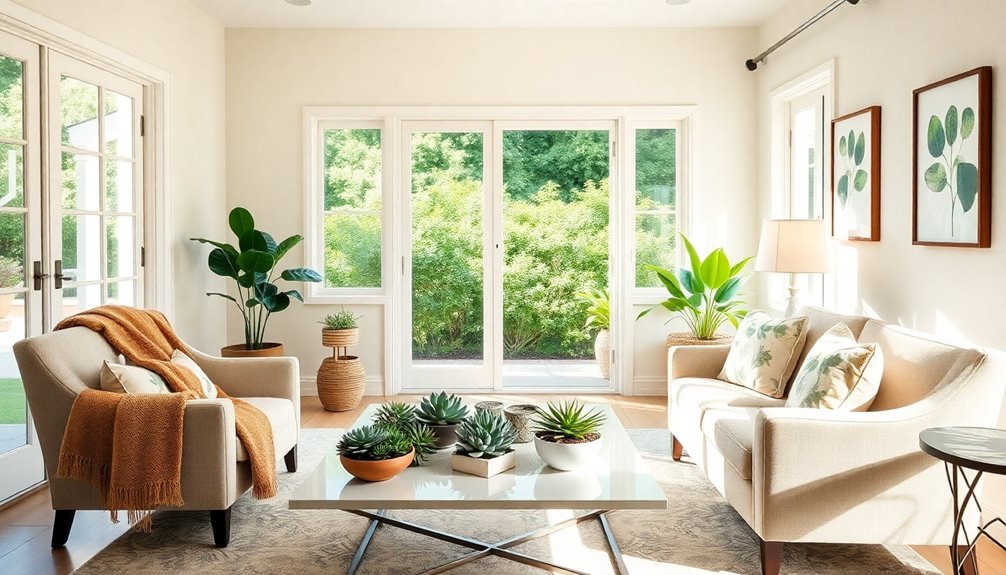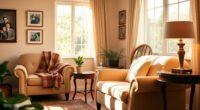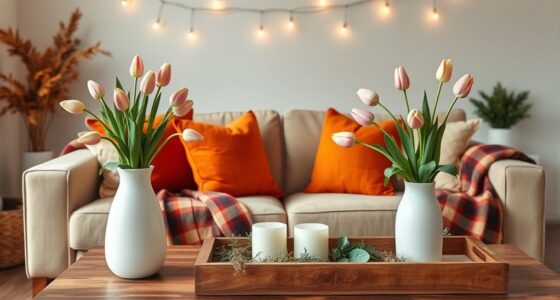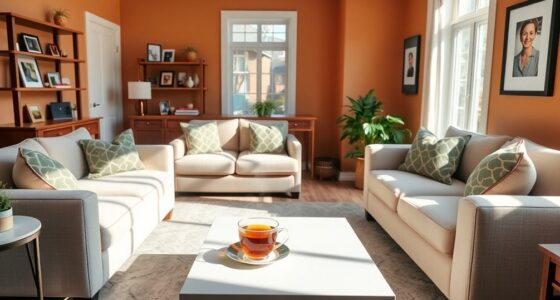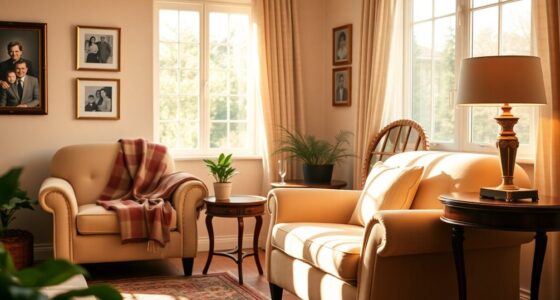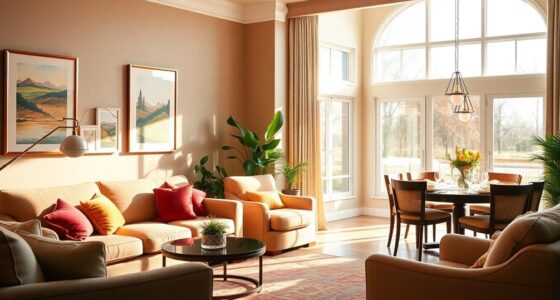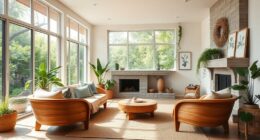To make aging in place stunningly beautiful, embrace natural light with large windows and soft treatments, and choose comfortable, safe furniture with rounded edges. Incorporate personal touches like family photos and artwork that tell your story, while using soft, calming color palettes for a tranquil atmosphere. Enhance functionality with smart technology that simplifies daily tasks, and create clutter-free zones with accessible storage solutions. Discover more tips to create a stylish and supportive environment that truly feels like home.
Key Takeaways
- Embrace natural light with large windows and soft, sheer treatments to create a warm and inviting atmosphere.
- Select comfortable and supportive furniture with rounded edges to enhance safety and ease of use.
- Personalize spaces with family photos and meaningful decor to foster emotional connections and warmth.
- Incorporate smart technology for safety and convenience, such as automated lighting and voice-activated assistants.
- Maintain a clutter-free environment using accessible storage solutions to promote independence and tranquility.
Embracing Natural Light for a Bright and Inviting Space
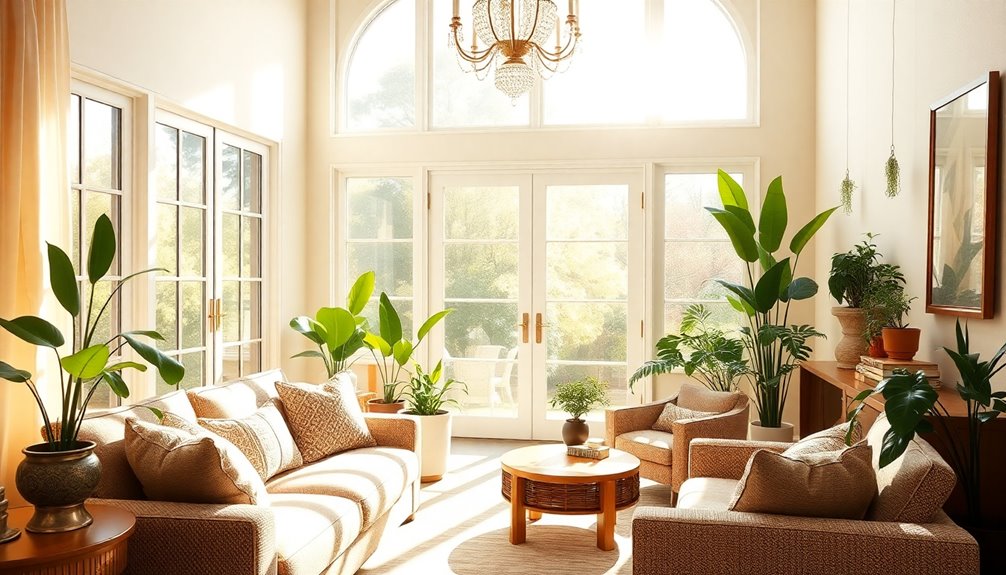
When you embrace natural light in your home, you not only brighten your space but also lift your spirits. This is particularly important in home design for aging in place.
Large windows and skylights can flood your rooms with sunlight, creating a warm atmosphere that combats feelings of depression. Consider using sheer window treatments that allow maximum light while preserving privacy.
Light-colored walls and reflective surfaces can amplify this natural light, making your home feel more spacious and inviting. Additionally, complementing natural light with layered lighting and dimmers guarantees visibility and safety, especially for seniors with vision impairments. Incorporation of natural elements promotes tranquility and enhances the overall ambiance of your living space.
Choosing Comfortable and Safe Furniture
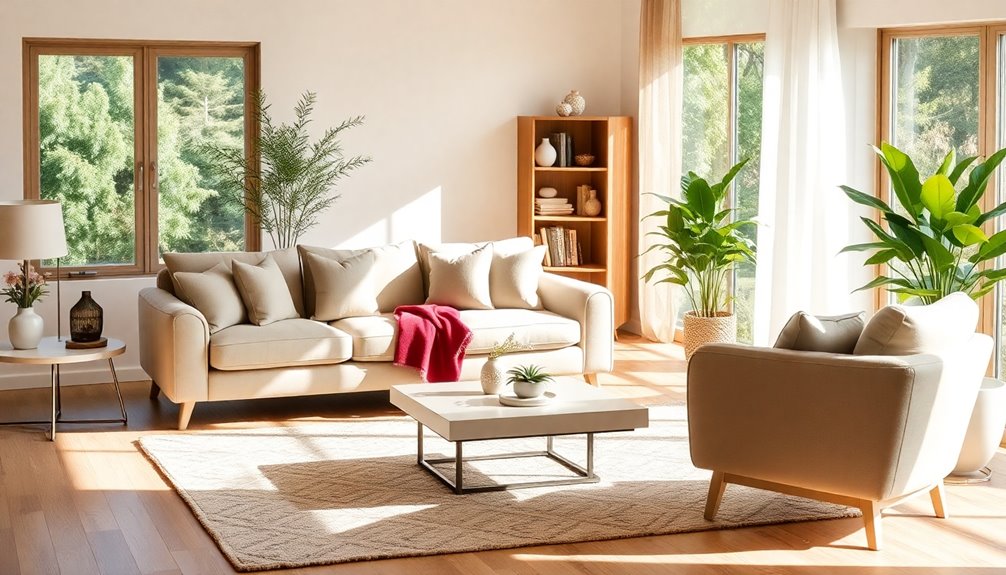
Choosing the right furniture is essential for creating a comfortable and safe living environment, especially as we age. Focus on selecting pieces that promote ease of use and safety. Look for furniture with a comfortable height to facilitate sitting and standing. Sofas and chairs should have firm cushions, ensuring stability as you shift in and out of your seat. Opt for furnishings with rounded edges to reduce the risk of injury. Additionally, consider incorporating furniture with easy to clean fabrics to maintain a practical and beautiful space.
| Furniture Type | Key Features | Benefits |
|---|---|---|
| Chairs | Comfortable height | Easy sitting and standing |
| Sofas | Firm cushions | Support and stability |
| Tables | Rounded edges | Safety from sharp corners |
| Ottomans | Lightweight | Flexible arrangements |
| Upholstery | Easy to clean fabrics | Practical and beautiful space |
Incorporating Personal Touches and Meaningful Decor
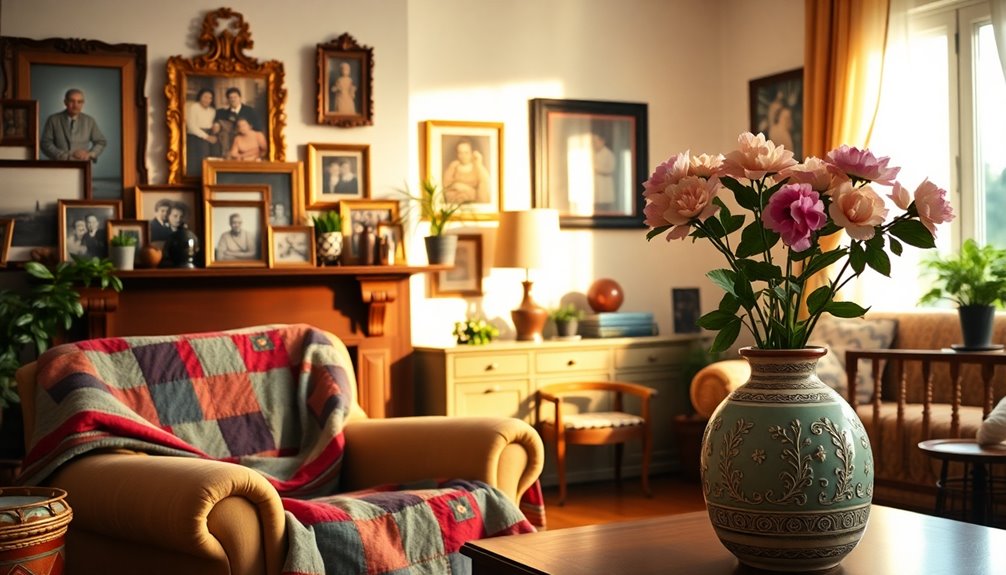
Incorporating personal touches into your decor can truly transform your space.
Think about creatively displaying family photos, showcasing your favorite artwork, or highlighting meaningful keepsakes that tell your story.
These elements not only add character but also make your home feel uniquely yours. Additionally, consider integrating tea accessories that reflect your personality and enhance the ambiance of your living area.
Family Photos Displayed Creatively
Creating a family photo display not only enhances your living space but also brings warmth and nostalgia into your home.
Here are some creative ideas to make your family photos shine while aging in place:
- Gallery Wall: Arrange photos in a gallery style to create a striking focal point.
- Diverse Frames: Use frames of various sizes and styles for added depth and personal flair.
- Shadow Boxes: Incorporate shadow boxes to showcase mementos like heirlooms or event memorabilia alongside your photos.
- Themed Sections: Create sections for family milestones, like vacations or anniversaries, to tell a cohesive story.
Ensure your display is at eye level, making it easy for seniors to reminisce and enjoy these cherished memories in their living spaces. Adding vintage accessories can further enhance the rustic charm of your photo display, creating a warm and inviting atmosphere.
Personalized Art and Crafts
When you add personalized art and crafts to your home decor, it transforms your space into a gallery of memories and emotions. For seniors aging in place, this sense of belonging and comfort is essential. By incorporating elements that resonate with their personal history and experiences, seniors can create an environment that not only reflects their style but also fosters emotional well-being. Implementing seniors comfort decor ideas can be as simple as displaying family photographs in unique frames or showcasing handmade crafts that evoke cherished memories. These thoughtful touches enhance the warmth of their living spaces, making them feel more at home and connected to their past.
Displaying family photos creatively in a gallery wall fosters connection and nostalgia, enhancing your emotional well-being. Handcrafted items, like quilts or pottery, not only beautify your surroundings but also showcase your history and creativity, infusing your home with sentimental value.
Customizable art pieces, such as name signs or monograms, add unique touches that make your living space feel more inviting. Engaging in craft projects can also promote mental stimulation and fine motor skills, making your home a vibrant and nurturing environment. Additionally, creating a tribute space allows you to honor cherished memories and loved ones, enriching your home with meaningful decor.
Meaningful Keepsakes and Mementos
Personalized art and crafts lay the groundwork for a home filled with memories, and adding meaningful keepsakes can deepen that connection.
These items not only reflect your personal interests but also foster an emotional connection to your space. Here are four ways to incorporate meaningful keepsakes into your decor:
- Family Photos: Display them in accessible spots to remind you of cherished moments and reduce loneliness.
- Shadow Boxes: Use them for awards or travel souvenirs, sharing your life stories with visitors.
- Personalized Decor: Choose items that reflect your hobbies or passions, creating a stimulating environment.
- Sentimental Furniture: Reupholster or customize beloved pieces to preserve family history while beautifying your home.
Additionally, consider incorporating personalized decor that includes elements like essential oils to enhance the ambiance and promote well-being in your space.
These touches make your space truly yours.
Utilizing Color Palettes for Calm and Comfort
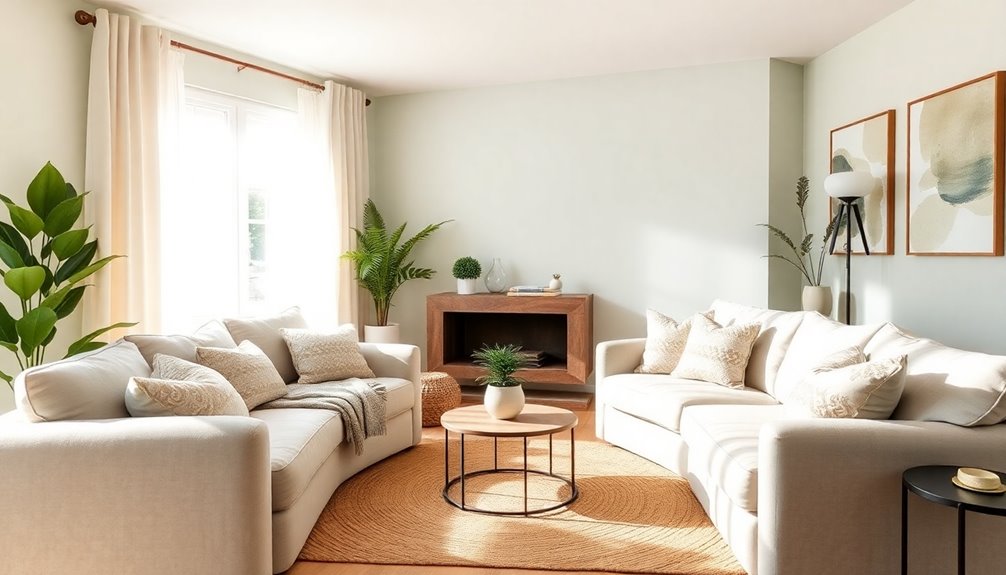
Incorporating soft, muted color palettes into your home can greatly enhance your sense of calm and comfort. Pastel blues and greens are excellent choices that promote tranquility, especially beneficial if you experience anxiety or stress.
Warm neutrals like taupe and beige can create a cozy atmosphere, making smaller rooms feel inviting. Additionally, consider using contrasting colors for furniture and walls; this improves visibility and helps navigate your space easily.
Embracing natural colors inspired by the outdoors, such as earthy browns and leafy greens, connects you to nature, fostering overall well-being. Furthermore, creating a budget plan for home decor can help you prioritize spending on items that enhance your living space while ensuring financial stability.
Finally, don't shy away from accent colors in moderation to highlight key areas, like a reading nook, enhancing your comfort and engagement in the space.
Enhancing Functionality With Smart Technology
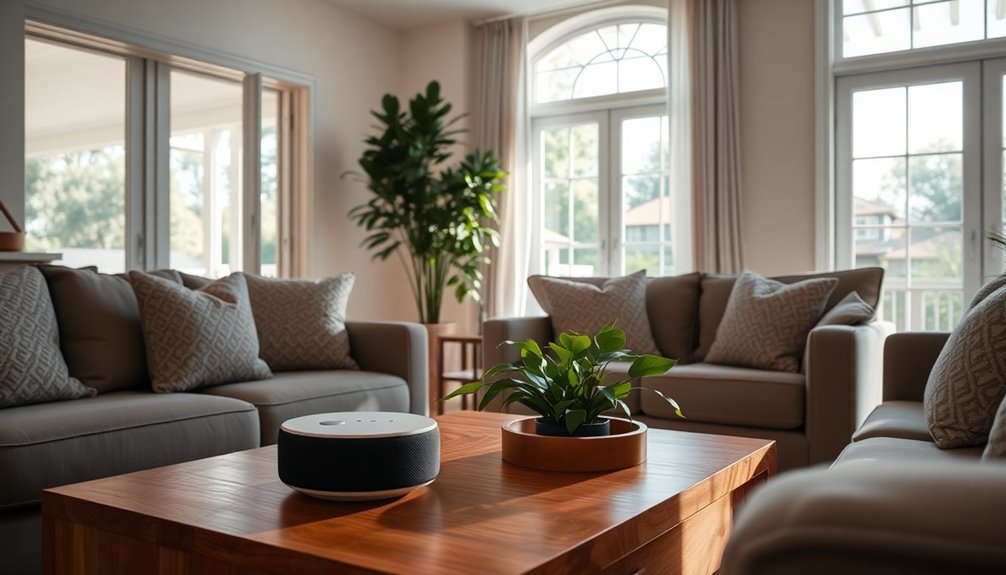
As you seek to enhance functionality in your home, smart technology can be a game-changer for aging in place. By incorporating smart home technologies, you can improve safety, comfort, and convenience.
Here are some options to evaluate:
- Voice-activated assistants for hands-free control of devices.
- Automated lighting that adjusts based on activity to reduce falls.
- Smart thermostats that optimize temperature settings for comfort.
- Home monitoring systems with motion sensors to keep family informed.
These innovations not only simplify daily tasks but also promote independence. Additionally, integrating home monitoring systems can significantly enhance security and peace of mind for seniors living alone.
Creating Clutter-Free and Accessible Environments
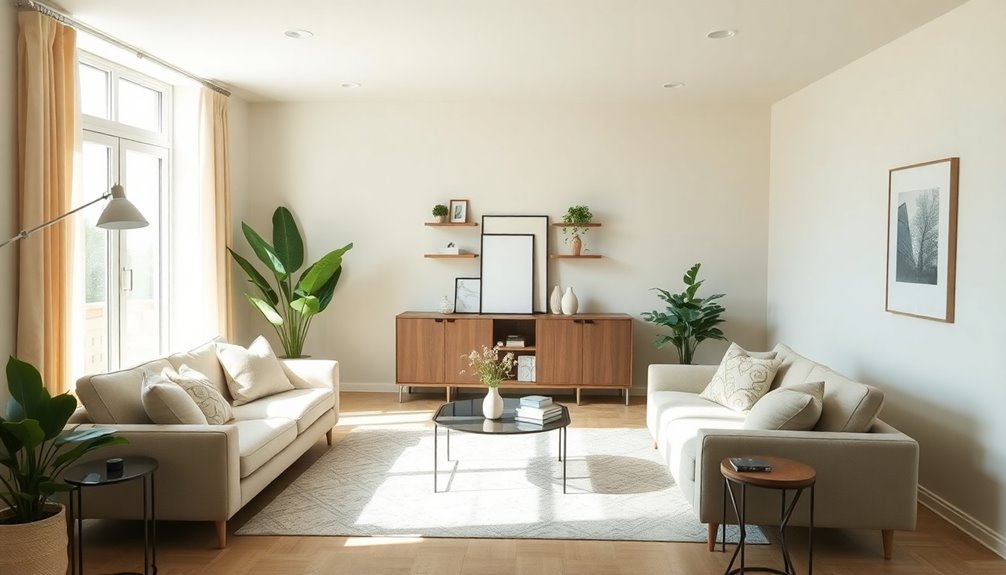
To create a clutter-free and accessible environment, start by evaluating your space and identifying areas where clutter accumulates.
Implementing smart storage solutions can keep essentials within easy reach, making daily tasks simpler.
Regularly organizing and decluttering not only enhances mobility but also promotes a sense of independence in your home. Additionally, mindful decluttering strategies can help maintain an organized space by encouraging responsible consumption habits.
Clutter Reduction Strategies
Creating a clutter-free environment not only enhances the aesthetic of your home but also greatly boosts your safety and mobility.
For older adults, implementing effective clutter reduction strategies is essential to maintain their ability to live independently. Here are four simple strategies to take into account:
- Establish a cleaning schedule: Regularly declutter to keep spaces tidy and organized.
- Create designated spaces: Assign specific spots for frequently used items to streamline access.
- Use multifunctional furniture: Incorporate items like ottomans with storage to minimize clutter.
- Utilize accessible storage solutions: Baskets and bins at reachable heights can help maintain organization.
Additionally, consider incorporating large indoor plants into your space, which can contribute to a calming atmosphere while being non-toxic for pets.
Accessible Storage Solutions
Accessible storage solutions are essential for fostering a clutter-free environment, especially for older adults who want to maintain their independence.
Implement closet organizers with adjustable shelves to guarantee you can easily reach frequently used items, reducing clutter and the risk of falls.
In kitchens and bathrooms, utilize pull-out drawers and bins to access items without bending or stretching.
Open shelving in living areas allows you to display items attractively while keeping them within easy reach, preventing clutter from taking over.
Multi-functional furniture, like ottomans with hidden storage, promotes tidiness.
Finally, design your storage solutions with rounded edges and smooth finishes to enhance safety, making your home not only beautiful but also supportive of aging in place.
Frequently Asked Questions
What Is the Best Home Design for Aging in Place?
The best home design for aging in place focuses on accessibility and safety.
You'll want to prioritize wide doorways and single-floor living to make mobility easier. Incorporate non-slip flooring and adequate lighting to reduce fall risks.
Arranging furniture to create clear pathways enhances movement. Don't forget grab bars in bathrooms and near stairs for added support.
Finally, consider smart home technology to simplify daily tasks and improve your overall living experience.
What Is Aging in Place in Interior Design?
Imagine living in a space that evolves with you, like a chameleon adapting to its surroundings.
Aging in place in interior design focuses on creating environments where you can maintain independence and safety as you grow older. It emphasizes practical features like wider doorways, non-slip floors, and smart technology.
How Do I Prepare My House to Age in Place?
To prepare your house to age in place, start by evaluating your home for necessary modifications.
Install grab bars, widen doorways, and guarantee clear pathways for easy navigation.
Consider creating a single-level living space or adding a primary suite on the main floor.
Incorporate smart technologies like motion sensor lights and prioritize non-slip flooring and ample lighting to enhance safety.
Finally, consult with Certified Aging in Place Specialists to create a customized plan that meets your needs.
How to Design a Home for Old People?
When designing a home for older people, comfort and safety should coexist harmoniously.
You'll want to create wider doorways and hallways for easy navigation, while choosing furniture that's both supportive and easy to use.
Soft, non-slip flooring will help prevent falls, and good lighting guarantees visibility.
Incorporate smart storage solutions so essentials are within reach—this way, you're promoting independence without sacrificing style or comfort in their living space.
Conclusion
As you weave these stunning decor ideas into your home, you'll transform it into a sanctuary that celebrates life at every age. Let natural light dance across your space, and choose furniture that cradles you in comfort. Infuse personal touches that tell your story, while calming colors wrap you in serenity. Embrace smart technology to enhance ease, and keep clutter at bay for a harmonious haven. Your home can be a beautiful reflection of your journey—embrace it!
